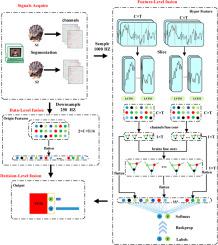Journal of Neuroscience Methods ( IF 3 ) Pub Date : 2021-08-30 , DOI: 10.1016/j.jneumeth.2021.109346 Hangkui Zhang 1 , Li Zhu 1 , Senwei Xu 1 , Jianting Cao 2 , Wanzeng Kong 3

|
Background. Rapid serial visual presentation (RSVP) based brain-computer interface (BCI) is widely used to categorize the target and non-target images. The available information limits the prediction accuracy of single-trial using single-subject electroencephalography (EEG) signals.
New Method. Hyperscanning is a new manner to record two or more subjects’ signals simultaneously. So we designed a multi-level information fusion model for target image detection based on dual-subject RSVP, namely HyperscanNet. The two modules of this model fuse the data and features of the two subjects at the data and feature layers. A chunked long and short-term memory artificial neural network (LSTM) was used in the time dimension to extract features at different periods separately, completing fine-grained underlying feature extraction. While the feature layer is fused, some plain operations are used to complete the fusion of the data layer to ensure that important information is not missed.
Results. Experimental results show that the F1-score (the harmonic mean of precision and recall) of this method with best group of channels and segment length is 82.76%.
Comparison with existing methods. This method improves the F1-score by at least 5% compared to single-subject target detection.
Conclusions. Target detection can be accomplished by the two subjects’ collaboration to achieve a higher and more stable F1-score than a single subject.
中文翻译:

两个大脑一个目标:基于双主体RSVP的多层次信息融合模型设计
背景。基于快速串行视觉呈现 (RSVP) 的脑机接口 (BCI) 被广泛用于对目标和非目标图像进行分类。可用信息限制了使用单受试者脑电图 (EEG) 信号进行单次试验的预测准确性。
新方法。超扫描是一种同时记录两个或多个对象信号的新方式。因此我们设计了一种基于双主体 RSVP 的目标图像检测多级信息融合模型,即 HyperscanNet。该模型的两个模块在数据和特征层融合了两个主体的数据和特征。在时间维度上使用分块长短期记忆人工神经网络(LSTM)分别提取不同时期的特征,完成细粒度的底层特征提取。在融合特征层的同时,通过一些简单的操作来完成数据层的融合,保证重要信息不被遗漏。
结果。实验结果表明,该方法的F1-score(准确率和召回率的调和平均值)具有最佳的通道组和段长,为82.76%。
与现有方法的比较。与单对象目标检测相比,该方法将 F1 分数提高了至少 5%。
结论。目标检测可以通过两个科目的合作来完成,以获得比单个科目更高、更稳定的 F1 分数。



























 京公网安备 11010802027423号
京公网安备 11010802027423号